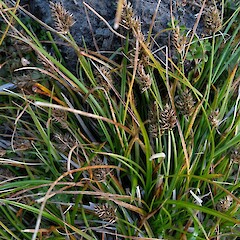Carex trachycarpa
Common name
sedge
Synonyms
None
Family
Cyperaceae
Flora category
Vascular – Native
Endemic taxon
Yes
Endemic genus
No
Endemic family
No
Structural class
Sedges
NVS code
The National Vegetation Survey (NVS) Databank is a physical archive and electronic databank containing records of over 94,000 vegetation survey plots - including data from over 19,000 permanent plots. NVS maintains a standard set of species code abbreviations that correspond to standard scientific plant names from the Ngä Tipu o Aotearoa - New Zealand Plants database.
CARTRA
Current conservation status
The conservation status of all known New Zealand vascular plant taxa at the rank of species and below were reassessed in 2017 using the New Zealand Threat Classification System (NZTCS) – more information about this can be found on the NZTCS website. This report includes a statistical summary and brief notes on changes since 2012 and replaces all previous NZTCS lists for vascular plants.
Please note, threat classifications are often suggested by authors when publications fall between NZTCS assessment periods – an interim threat classification status has not been assessed by the NZTCS panel.
- Conservation status of New Zealand indigenous vascular plants, 2017 . 2018. Peter J. de Lange, Jeremy R. Rolfe, John W. Barkla, Shannel P. Courtney, Paul D. Champion, Leon R. Perrie, Sarah M. Beadel, Kerry A. Ford, Ilse Breitwieser, Ines Schönberger, Rowan Hindmarsh-Walls, Peter B. Heenan and Kate Ladley. Department of Conservation. Source: NZTCS and licensed by DOC for reuse under the Creative Commons Attribution 4.0 International licence.
2017 | At Risk – Naturally Uncommon | Qualifiers: RR, Sp
Previous conservation statuses
2012 | At Risk – Naturally Uncommon | Qualifiers: RR, Sp
2009 | At Risk – Naturally Uncommon
2004 | Range Restricted
Distribution
Endemic. South Island, North West Nelson, Kahurangi National Park mainly in and around Mt Owen, Mt Arthur, Mt Peel and Mt Mytton.
Habitat
A calcicole of marble and limestone subalpine to alpine habits where it it is found within tussock grassland, herbfield, fell field, gravel and rock pavements, usually in and around small ponds, seepages or flushes.
Wetland plant indicator status rating
Information derived from the revised national wetland plant list prepared to assist councils in delineating and monitoring wetlands (Clarkson et al., 2021 Manaaki Whenua – Landcare Research Contract Report LC3975 for Hawke’s Bay Regional Council). The national plant list categorises plants by the extent to which they are found in wetlands and not ‘drylands’. The indicator status ratings are OBL (obligate wetland), FACW (facultative wetland), FAC (facultative), FACU (facultative upland), and UPL (obligate upland). If you have suggestions for the Wetland Indicator Status Rating, please contact: [Enable JavaScript to view protected content]
OBL: Obligate Wetland
Almost always is a hydrophyte, rarely in uplands (non-wetlands).
Detailed description
Grassy, distinctly tufted sedge arising from stout, shortly ascending, woody rootstock. Culms 70–300 x c. 1 mm, trigonous, grooved, mainly smooth though rather faintly scabrid below inflorescence; basal sheaths light brown. Leaves 5–7–(10) per culm, these less than, equal to or even greater than culm length, 2.5 mm wide, channelled, margins finely scabrid toward the apex. Inflorescence a compact head 10–15 × 7 mm, composed of densely packed light or dark brown spikes. Spikes with 1–3 males at the top, lowermost 1–3 spikes subtended by a membranous, lanceolate bract whose mid vein is extended as a long scabrid awn; this sometimes exceeding the inflorescence in length. Glumes equal to or just longer than utricles, ovate, acuminate or occasionally awned, membranous, chestnut-brown to light brown, keel green, scabrid in lowermost glumes entire otherwise, margins hyaline, occasionally very broad towards glume apex. Utricles 3 × 1 mm, plano-convex, strongly nerved, dull, minutely papillose all over; slightly tapering to a beak c. 1 mm long with scabrid margins and an oblique, bifid crura; stipe 0.3 mm. Stigmas 2. Nut 1.5 mm, light yellow-brown, plano-convex, oblong, smooth.
Similar taxa
The distinctive grass-like tufted growth habit, conspicuous leaf-like bracts subtended the densely packed spikes of the inflorescence, and the finely (minutely) papillose utricles distinguish this species from other New Zealand carices. In Vol. II of the New Zealand Flora series it keys out closest to the very different C. pterocarpa (see comments under that species).
Flowering
November–December
Fruiting
November–May
Life cycle
Nuts surrounded by inflated utricles are dispersed by granivory and wind (Thorsen et al., 2009).
Propagation technique
Little known and not commonly cultivated. Plants grow well from fresh seed and by division of established specimens. Probably best kept in a pot and likely to dislike humid or wet climates. This plant is likely to prefer a free draining highly fertile soil.
Threats
Not Threatened. A narrow range endemic abundant within its few known habitats, and apparently secure in all of these.
Etymology
carex: Latin name for a species of sedge, now applied to the whole group.
Where To Buy
Not commerically available.
Attribution
Fact Sheet prepared by P.J. de Lange (10 August 2006). Description adapted from Moore and Edgar (1970)
References and further reading
Moore LB, Edgar E. 1970. Flora of New Zealand, Volume II. Indigenous Tracheophyta: Monocotyledones except Gramineae. Government Printer, Wellington, NZ. 354 p.
Thorsen MJ, Dickinson KJM, Seddon PJ. 2009. Seed dispersal systems in the New Zealand flora. Perspectives in Plant Ecology, Evolution and Systematics 11: 285–309.
NZPCN Fact Sheet citation
Please cite as: de Lange, P.J. (Year at time of access): Carex trachycarpa Fact Sheet (content continuously updated). New Zealand Plant Conservation Network. https://www.nzpcn.org.nz/flora/species/carex-trachycarpa/ (Date website was queried)






